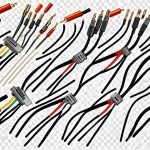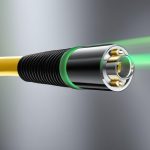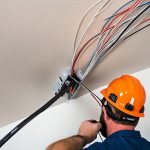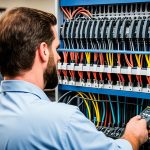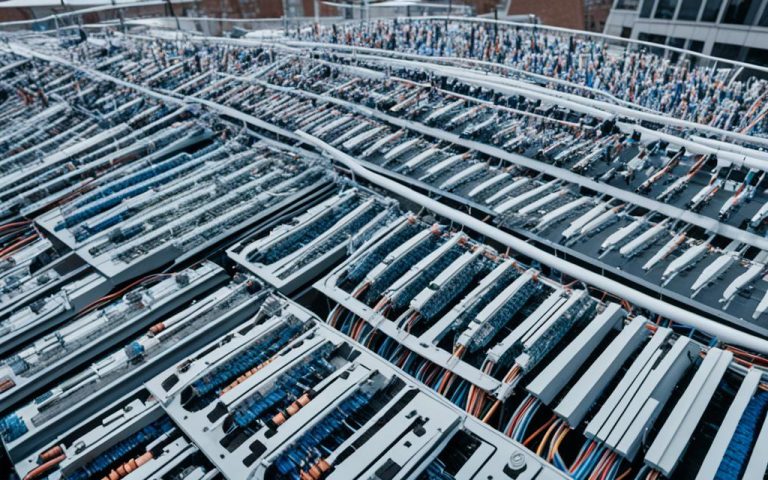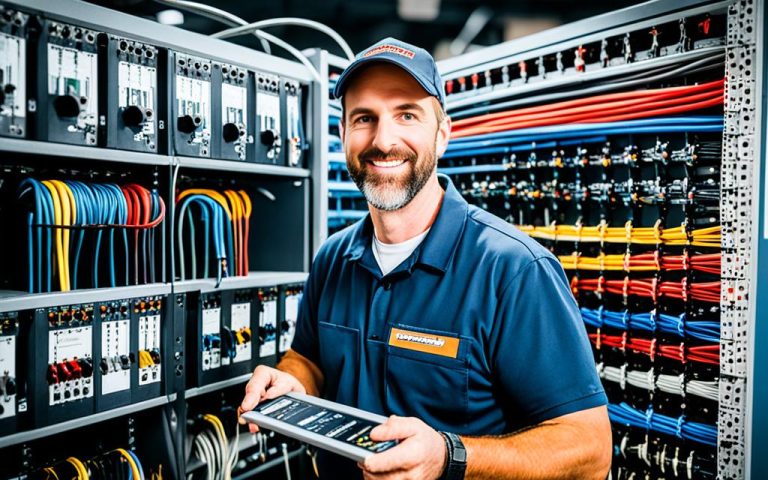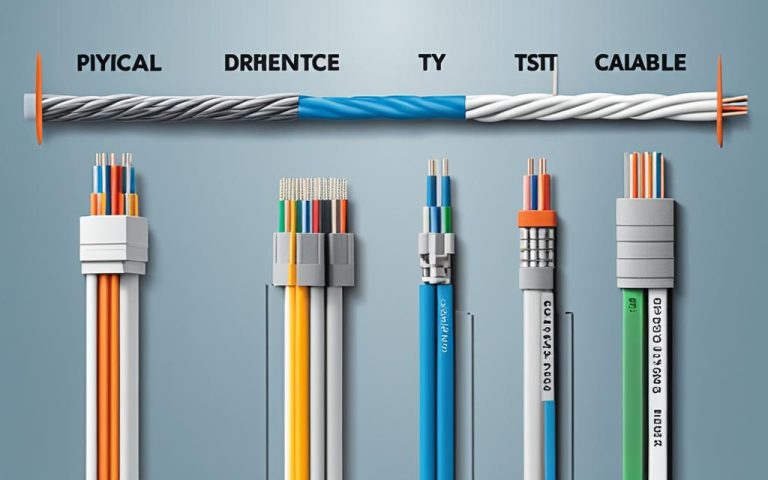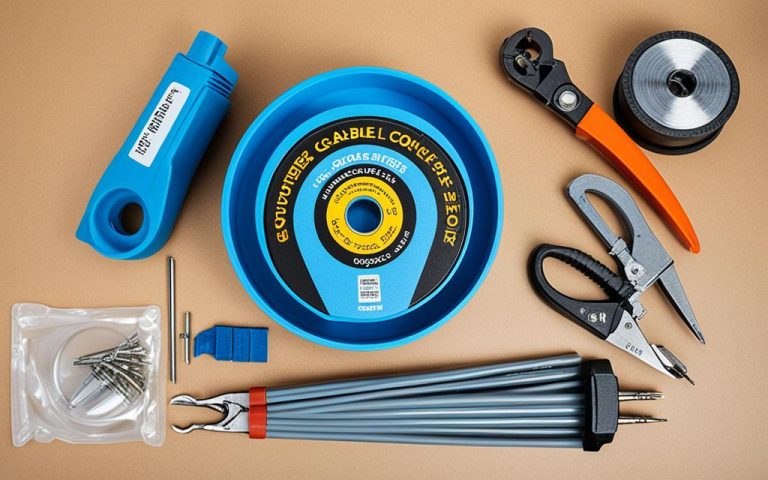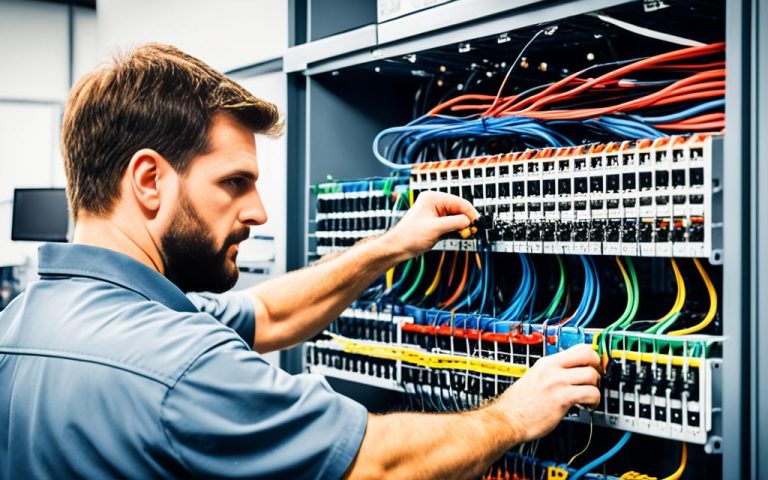Coaxial cable, a key component in smart home infrastructures, plays a vital role in enhancing connectivity, enabling high-speed internet access, and efficient media distribution. In today’s increasingly connected world, smart homes rely on robust and reliable networks to support a wide range of smart devices and technologies.
With the growing demand for smart homes, the need for seamless connectivity has become more important than ever. Coaxial cable provides the backbone for reliable and high-speed internet connections, allowing for smooth streaming, online gaming, and seamless integration of smart devices throughout the home.
Whether it’s streaming multimedia content in different rooms, controlling smart thermostats and security systems, or enjoying immersive entertainment experiences, coaxial cabling ensures optimal performance and connectivity for smart homes.
In this article, we will explore the benefits and importance of integrating coaxial cabling into smart home infrastructures. We will delve into how coaxial cable enhances connectivity, supports high-speed internet, and facilitates efficient media distribution within smart homes. Additionally, we will discuss the various applications and advantages of coaxial cabling, focusing on its role in creating a connected and convenient living environment.
Join us as we discover how the integration of coaxial cabling revolutionizes the way we live in smart homes, delivering high-speed internet, seamless connectivity, and enhanced media distribution.
The Importance of Pre-Wiring in Smart Homes
In the rapidly advancing world of smart homes, pre-wiring is an essential foundation for seamless integration and optimal performance. It serves as the invisible backbone that enables the connectivity and functionality of various smart features, enhancing the overall living experience. From automated lighting and thermostats to security cameras and audiovisual systems, pre-wiring ensures that these smart features work harmoniously together, transforming a regular home into a fully-equipped smart home.
One of the key advantages of pre-wiring is its ability to future-proof the home. By anticipating and accommodating future technological advancements, pre-wiring provides homeowners with the flexibility to easily adapt to new smart technologies as they emerge. This forward-thinking approach helps to avoid the need for costly retrofits and ensures that the home remains up-to-date with the latest innovations.
Furthermore, pre-wiring contributes to the energy efficiency of smart homes. By strategically routing cables and wiring throughout the premises, energy consumption can be optimized. For example, smart lighting systems can be wirelessly controlled, allowing homeowners to effortlessly manage and schedule lighting usage, resulting in energy savings.
In addition to energy efficiency, pre-wiring enhances safety and security. With pre-wired security cameras and sensors, homeowners can monitor their property remotely and receive real-time notifications of any potential threats or emergencies. This added layer of protection provides peace of mind and a heightened sense of security.
Another significant benefit of pre-wiring is the value it adds to the property. A home equipped with a comprehensive pre-wiring infrastructure is appealing to potential buyers, as it offers a turnkey solution for smart home integration. Buyers recognize the convenience and potential cost savings that pre-wiring provides, making the property more desirable and valuable in the market.
Key benefits of pre-wiring in smart homes:
- Seamless integration of smart features
- Future-proofing the home
- Enhancing energy efficiency
- Improving safety and security
- Adding value to the property
For a visual representation of the importance of pre-wiring in smart homes, refer to the table below:
| Benefits of Pre-Wiring |
|---|
| Seamless integration of smart features |
| Future-proofing the home |
| Enhancing energy efficiency |
| Improving safety and security |
| Adding value to the property |
By prioritizing pre-wiring in smart home installations, homeowners can unlock the true potential of their living spaces. With a solid foundation in place, smart homes can deliver unparalleled convenience, energy efficiency, and connectivity, catering to the evolving needs and desires of modern living.
Understanding the Types of Cables Used in Smart Homes
When it comes to building a smart home, a diverse range of cables are required to support various systems and devices. Each type of cable serves a specific purpose in ensuring seamless connectivity and functionality throughout the home. Let’s explore the different types of cables commonly used in smart homes:
1. Category Cables
Category cables, such as Cat 6 or Cat 6a, are indispensable for internet connectivity, phone lines, and audio/video systems. With their high bandwidth capabilities, these cables provide fast and reliable data transfer, ensuring smooth streaming, online gaming, and file sharing experiences.
2. Coaxial Cables
Coaxial cables are essential for transmitting cable TV and satellite signals to televisions and entertainment systems. With efficient shielding against interference, coaxial cables deliver high-quality audio and video signals, enhancing the entertainment experience in smart homes.
3. Speaker Wire
To create a surround sound experience in home theaters or distributed audio systems, speaker wire is used to connect speakers to audio devices. Designed to carry high-quality audio signals, speaker wire ensures crisp and clear sound reproduction throughout the smart home.
4. Security System Cables
Security is a top priority in smart homes, and security system cables play a crucial role in connecting various components. These cables connect sensors, cameras, control panels, and other security devices, ensuring efficient communication and reliable operation of the home security system.
5. Thermostat Wire
Smart temperature control systems rely on thermostat wire to connect thermostats with heating, ventilation, and air conditioning (HVAC) units. This type of wire enables seamless integration, allowing homeowners to control and monitor temperature settings remotely, optimizing energy usage and enhancing comfort.
By using the right type of cable for each specific application, smart homes can achieve optimal performance and efficiency. These cables not only provide the necessary connectivity but also contribute to the overall functionality and convenience of a modern smart home.
“Smart homes rely on a combination of cables to provide connectivity and enable automation. Understanding the different types of cables used is essential for building a robust and future-proof smart home infrastructure.”
Enhancing Aesthetics in Smart Homes with Concealed Wiring
Concealed wiring plays a critical role in elevating the aesthetics of smart homes. By centralizing devices and running cables behind walls, homeowners can seamlessly integrate smart home technology without compromising the overall design and ambiance of the space. This minimalistic approach eliminates the need for visible wires, creating a clean and clutter-free environment that enhances the aesthetics of the home.
Smart home technology is designed to make our lives more convenient and efficient. However, the presence of visible wires and cables can disrupt the visual harmony and sleekness of the living space. Concealed wiring solves this problem by keeping the infrastructure hidden, allowing smart homes to achieve a seamless blend of technology and design.

With concealed wiring, homeowners can enjoy the benefits of smart home technology without compromising on aesthetic appeal. By centralizing devices, such as control panels and hubs, in a designated space, the need for scattered cables and wires throughout the house is eliminated. This centralization not only reduces clutter but also allows for easier access and management of the smart home system.
In a minimalistic design, every element plays a crucial role in achieving a clean and streamlined look. Concealed wiring acts as the foundation for this design philosophy, ensuring that the technology seamlessly integrates into the overall aesthetic of the home.
By running cables behind walls, homeowners can achieve a sleek and minimalistic design that showcases the beauty of their living space, free from unsightly wires. Concealed wiring allows for the creation of clean lines and unobstructed surfaces, enhancing the visual appeal and flow of the room. Whether it’s a minimalist living room, a modern kitchen, or a luxury bedroom, concealed wiring enables smart home technology to complement the existing design elements and create a harmonious atmosphere.
Furthermore, concealed wiring enables the flexibility to incorporate various smart home devices and systems without compromising the aesthetics. From lighting control and audio distribution to security cameras and motorized shades, the seamless integration of these elements enhances the functionality of the home while maintaining a clean and visually appealing environment.
Advantages of Concealed Wiring:
- Ensures a clean and clutter-free environment
- Creates a sleek and minimalistic design
- Promotes visual harmony and flow
- Allows for easy access and management of smart home devices
- Flexibility to incorporate various smart home systems
In conclusion, concealed wiring is essential for enhancing the aesthetics of smart homes. By integrating smart home technology through centralized and concealed wiring, homeowners can achieve a harmonious blend of functionality and design. This approach creates a clean and clutter-free environment, allowing the beauty of the living space to take center stage while seamlessly incorporating the conveniences of modern technology.
Ensuring a Solid Backbone for Smart Home Connectivity
To ensure reliable and robust connectivity throughout the entire home, a solid backbone is essential. A single broadband router may not provide sufficient wireless coverage, resulting in areas with weak signals. This can be overcome by strategically installing wireless access points and hardwired connections, creating a network that guarantees optimal performance and eliminates issues like slow loading and buffering.
Wireless access points serve as extensions of the router, expanding the coverage and improving signal strength in various areas of the home. By strategically positioning these access points, homeowners can enjoy seamless connectivity across all rooms and floors. This ensures a consistent internet connection for streaming, online gaming, and smart device integration.
However, relying solely on wireless connections may still pose limitations in terms of range and signal strength. To further enhance connectivity and ensure exceptional performance, the use of hardwired connections is highly recommended. By directly connecting devices such as smart TVs, gaming consoles, and media servers to the network via Ethernet cables, homeowners can experience faster and more reliable data transfer.
Hardwired connections not only offer superior performance but also provide added security and stability. These connections eliminate the risk of signal interference from external devices or neighboring networks, resulting in a more consistent and uninterrupted experience. Additionally, hardwired connections are especially beneficial for devices that require a high bandwidth, such as 4K streaming devices or home theater systems.
By combining wireless access points and hardwired connections, homeowners can create a comprehensive network infrastructure that maximizes wireless coverage and performance. This ensures that no corners of the home are left with weak or unreliable connectivity. Whether it’s streaming movies, playing online games, or managing smart home devices, a solid backbone is crucial for a seamless and enjoyable user experience.

“A solid backbone is the foundation for a reliable and high-performance smart home network. By strategically installing wireless access points and incorporating hardwired connections, homeowners can enjoy optimal connectivity and eliminate common issues like slow loading or buffering.”
Planning for the Future in Smart Home Infrastructure
Smart home infrastructure should be designed with future applications in mind. As rooms may undergo repurposing or transformation over time, it is crucial to have the necessary cables already installed during the construction phase. This forward-thinking approach ensures future-proofing the home and allows for the easy addition of devices without the need for extensive renovations or trailing wires.
Benefits of Future-Proofing:
- Flexibility: By incorporating a robust cable infrastructure during the initial construction phase, homeowners can adapt to evolving technologies and seamlessly integrate new devices without disrupting the existing layout.
- Room Transformation: As homeowners repurpose rooms for different functions, having pre-installed cables offers the versatility to support various smart devices and technologies, such as home offices, entertainment centers, or fitness areas.
- Enhanced Versatility: Future-proofing allows for the easy integration of emerging technologies and systems, such as advanced home automation, virtual reality, or augmented reality, without major modifications to the existing cable infrastructure.
By planning for the future and investing in a comprehensive cable infrastructure, smart home owners can enjoy the benefits of seamless device integration, flexibility in room transformations, and enhanced versatility for future technological advancements.
| Future-Proofing Benefits | Flexibility | Room Transformation | Enhanced Versatility |
|---|---|---|---|
| Summary | Allows for adaptation to evolving technologies without disrupting the existing layout. | Supports various smart devices and technologies as rooms are repurposed for different functions. | Enables easy integration of emerging technologies and systems without major modifications. |
Choosing the Right Partner for Smart Home Technology
When it comes to integrating smart home technology, selecting the right home technology company is crucial. With the rapid advancements in home automation, it’s essential to work with a reputable company that has a proven track record of expertise and industry certifications. One such certification to look for is from CEDIA, the leading global authority in the home technology industry.
By partnering with a home technology company that holds industry certifications, you can be confident in their knowledge and commitment to providing high-quality service and installations. These certifications validate the company’s expertise and ensure that they meet specific standards of excellence.
Working with an experienced home technology company offers numerous benefits. Their extensive industry knowledge allows them to design custom solutions tailored to your unique requirements. With their expertise, they can recommend the most innovative and reliable smart home products, ensuring optimal performance and user experience.
A company’s reputation is also a crucial factor to consider. Look for testimonials and reviews from previous clients to gain insights into their customer service and the quality of their work. A reputable home technology company will have a solid reputation for delivering exceptional service and exceeding customer expectations.
“Choosing the right partner for your smart home technology integration can make all the difference in the success of your project. The right company will not only provide superior design and installation but also ensure a seamless and stress-free experience for you as the homeowner.” – Sarah Thompson, Smart Home Enthusiast
Benefits of Choosing the Right Home Technology Company
- Access to Expertise: A reputable company brings years of experience and knowledge, providing expert advice and recommendations.
- Quality Design and Installation: With their industry certifications, they ensure precise and efficient installations to deliver optimal performance.
- Customer Service: A home technology company with a solid reputation prioritizes customer satisfaction, offering prompt and reliable support.
By partnering with the right home technology company, you can enjoy a seamless integration of smart home technology into your living space, enhancing comfort, convenience, and overall quality of life.
| Key Considerations | Benefits |
|---|---|
| Reputation | Assurance of quality service and customer satisfaction |
| Expertise and Certifications | Access to knowledgeable professionals and industry-leading standards |
| Custom Solutions | Tailored design to meet your specific smart home needs |
| Innovative Products | Recommendations for cutting-edge technology to ensure optimal performance |
Conclusion
Integrating coaxial cabling into smart home infrastructures is crucial for ensuring seamless connectivity, efficient integration of smart features, and future-proofing the home for upcoming technological advancements. By establishing a well-planned and properly installed cable infrastructure, smart homes can achieve optimal performance, robust connectivity, and unparalleled convenience for homeowners.
Coaxial cable plays a pivotal role in enhancing connectivity within smart homes. It enables high-speed internet access and efficient distribution of media throughout the home, ensuring a seamless and immersive smart home experience.
Furthermore, integrating coaxial cabling into the smart home infrastructure is a future-proof solution. As technology continues to advance, homeowners can easily adapt and incorporate new smart features without the need for extensive renovations or disruptive installations. This flexibility allows for room transformations and ensures that the home remains up-to-date with the latest advancements in the industry.
To achieve optimal performance, it is essential to have a solid backbone for connectivity within smart homes. By strategically installing wireless access points and hardwired connections, homeowners can eliminate issues such as weak signals or slow loading speeds, guaranteeing a seamless and uninterrupted user experience.
FAQ
Why is coaxial cable important in smart home infrastructures?
Coaxial cable plays a crucial role in enhancing connectivity in smart homes, enabling robust and high-speed internet access as well as efficient media distribution.
What is the importance of pre-wiring in smart homes?
Pre-wiring is the invisible backbone of smart homes, allowing for the seamless integration of various smart features such as automated lighting, thermostats, and security cameras. It also future-proofs the home, ensuring it stays ahead of technological advancements, contributes to energy efficiency, enhances safety, and adds value to the property.
What types of cables are used in smart homes?
Smart homes require different types of cables for various services. Category cables, such as Cat 6 or Cat 6a, are commonly used for internet, phone lines, and audio/video systems. Coaxial cables are used for cable TV and satellite signals, while speaker wire connects speakers to audio systems. Security system cables connect sensors, cameras, and control panels, and thermostat wire enables smart temperature control.
How does concealed wiring enhance the aesthetics of smart homes?
Concealed wiring is crucial for maintaining the aesthetic appeal of smart homes. By centralizing devices and running cables behind walls, smart home technology can be seamlessly integrated without compromising the overall design of the space. This minimalistic approach eliminates the need for visible wires and ensures a clean and clutter-free environment.
How can a solid backbone ensure reliable connectivity in smart homes?
To ensure reliable and robust connectivity throughout the entire home, a solid backbone is essential. A single broadband router may not provide sufficient wireless coverage, resulting in areas with weak signals. This can be overcome by strategically installing wireless access points and hardwired connections, creating a network that guarantees optimal performance and eliminates issues like slow loading and buffering.
Why is it important to plan for the future in smart home infrastructure?
Smart home infrastructure should be designed with future applications in mind. As rooms may be repurposed or transformed over time, it is important to have the necessary cables already installed during the construction phase. This future-proofs the home and allows for the easy addition of devices without the need for extensive renovations or trailing wires.
How do I select the right partner for smart home technology integration?
Selecting the right home technology company is crucial for a successful smart home integration. Working with a reputable company that has extensive experience, industry certifications, and a solid reputation ensures quality design, installation, and customer service. CEDIA, the certifying body for the home technology industry, is a reliable resource for finding qualified and certified professionals in the field.
What are the benefits of integrating coaxial cabling into smart home infrastructures?
Integrating coaxial cabling into smart home infrastructures is essential for enhancing connectivity, enabling seamless integration of smart features, and future-proofing the home for technological advancements. With a well-planned and properly installed cable infrastructure, smart homes can achieve optimal performance, connectivity, and convenience for homeowners.


